Around The Oval
Homecoming 2003It was a picture-perfect Homecoming, with weather in the 70s, the second largest parade ever, alumni returning from all corners of the globe, and a 17-14 win over Cal Poly.
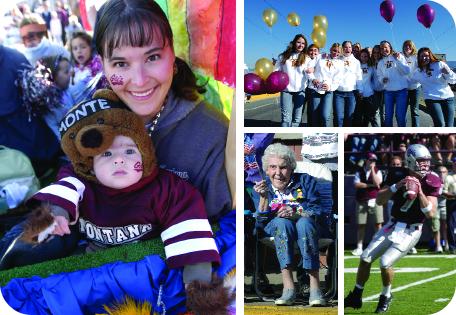
Greetings from the President
 I recently returned from a trip to South Korea and Japan designed to cement relationships with cooperating universities in those two countries. These relationships provide opportunities for students, staff, and faculty to participate in exchanges and symposia, thereby enriching the educational experience available to them at UM. I continue to believe that students in the twenty-first century need an international experience during their academic careers, for we know well that these students will live in a global society.
I recently returned from a trip to South Korea and Japan designed to cement relationships with cooperating universities in those two countries. These relationships provide opportunities for students, staff, and faculty to participate in exchanges and symposia, thereby enriching the educational experience available to them at UM. I continue to believe that students in the twenty-first century need an international experience during their academic careers, for we know well that these students will live in a global society.
Of course, the challenge for the University comes in helping students manage the expense and the time required for such an experience. It frequently happens that students must sacrifice a semester or even a year to participate in international exchanges. In discussions with representatives of the cooperating universities in other countries, we will seek to make certain that the credits will count toward graduation by including courses that contribute toward the students’ majors. Achieving that result will require careful planning and much more coordination of curricula. Nonetheless, I believe we can accomplish the objective, and we will work toward that end.
In addition, we will plan very carefully the symposia that we sponsor jointly with other institutions. From these symposia will come joint research efforts and collaborative degree programs that will prove even more valuable to our students, staff, and faculty. UM has a distinguished record in international education that will serve well as the foundation for future initiatives. We must do more in order to serve the students in this new era.
![]()
George M. Dennison ’62
President
Bringing the Outside In
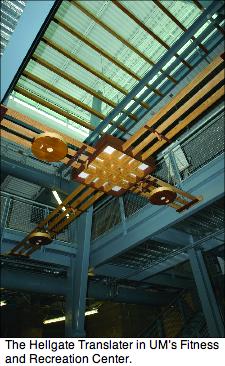 Workout time. You enter the building, swipe your Griz card through the meter, and push past the entry gate, intent on logging some flights on the Stairmaster, then lifting a few weights.
Workout time. You enter the building, swipe your Griz card through the meter, and push past the entry gate, intent on logging some flights on the Stairmaster, then lifting a few weights.
From overhead you hear a noise. Thwo-o-o-o-n-n-n-g. Eh? You crank your neck and look ceiling-ward, where you see what looks like four pared-down, futuristic banjoes connected to a large box bisected by a tic tac toe grid. Thunk-twa-a-a-ang. What the . . . ?
In a fusion of art and science, Patrick Zentz, M.F.A. ’74, has created the “Hellgate Translator,” an oak, mahogany and plexiglass sculpture suspended in the atrium of UM’s Fitness and Recreation Center.
Raised on a ranch southwest of Billings, Zentz is widely recognized as an innovative artist and an inventive sculptor, known for work that examines man and nature in a modern context. He now divides his time between ranching and his art installations, which appear across the country.
Meticulously crafted and often beautiful, Zentz’ mechanisms are energized by the forces of nature—wind, flowing water, changing temperatures—and register these elements in mediated graphic or musical forms.
The environmentally interactive system in the rec center, specifically designed for the space it occupies, translates the flow of air outside the building into acoustic patterns in the lobby.
Here’s how it works: on the roof, an anemometer, measuring wind speed, and a wind vane, indicating wind direction, send electronic signals to a control panel hidden within the sculpture. Inside, a programmed computer chip commands the movement of four mallets that strike corresponding strings. For example, if the wind blows from the north, the north mallet strikes its companion string, producing a tone specific to that direction. When the wind blows from the east, the east string sounds its own tone. And when the wind blows from the northeast, the tones are heard together. The harder the wind blows, the more forcefully the wires are struck. The Translator, in effect, brings outside information, normally occluded from perception, inside the building.
Intrigued? Come see—and hear—for yourself. It’s beautiful. It’s dynamic. It’s art. – Paddy MacDonald
Grizzly Greats
 Four Grizzly standouts who went on to play in the National Football League have been inducted into the UM Grizzly Hall of Fame. This year’s inductees included defensive end Doug Betters ’78, who played ten seasons for the Miami Dolphins and was named the NFL’s Defensive Player of the Year in 1983, and Guy Bingham ’84, the 1981 tenth-round draft pick of the New York Jets, who also played for the Atlanta Falcons and the Washington Redskins. Also inducted were offensive lineman Kirk Scrafford, who played for nine seasons in the league, and defensive lineman Mike Tilleman ’65, who started for eleven NFL seasons.
Four Grizzly standouts who went on to play in the National Football League have been inducted into the UM Grizzly Hall of Fame. This year’s inductees included defensive end Doug Betters ’78, who played ten seasons for the Miami Dolphins and was named the NFL’s Defensive Player of the Year in 1983, and Guy Bingham ’84, the 1981 tenth-round draft pick of the New York Jets, who also played for the Atlanta Falcons and the Washington Redskins. Also inducted were offensive lineman Kirk Scrafford, who played for nine seasons in the league, and defensive lineman Mike Tilleman ’65, who started for eleven NFL seasons.
Alumni Honored for Leadership
UM alumni Ken Toole ’79 and Christine Kaufmann ’87, co-founders of the Montana Human Rights Network in Helena, recently received national recognition, winning a 2003 award from Leadership for a Changing World. The program is sponsored by the Ford Foundation, the Advocacy Institute in Washington, D.C., and the Robert F. Wagner School of Public Service at New York University.
The MHRN leadership team is one of seventeen awardees, selected from a pool of more than 1,300 nominations, representing individuals and groups that tackle some of the nation’s most entrenched social problems. Each will receive $100,000 to advance their work and an additional $15,000 for supporting activities over the next two years.
With a small staff, Toole and Kaufmann built MHRN, a membership-based association whose mission is to promote democratic values, challenge bigotry and intolerance, and organize communities to speak out.
From confronting extremist militia organizations to advocating for gay rights and tribal sovereignty, program administrators describe Toole and Kaufmann’s work as that of unflinching spokespersons for social justice.
“These awards recognize the achievement of remarkable people working to bring positive social change to their communities and beyond,” says Susan V. Berresford, president of the Ford Foundation. The program also includes a major, multi-year collaborative research initiative that works with awardees to explore how leadership is created and sustained.
Brush Your Teeth, Vote for Monte
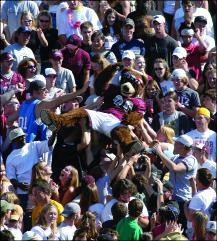 Monte, our own widely celebrated, motorcycle-riding, crowd-pleasing, baby-hugging Grizzly mascot, has been named again to the Capital One All-America Mascot Team. This is the first step in a quest to retain the 2003 National Mascot of the Year title he won last January.
Monte, our own widely celebrated, motorcycle-riding, crowd-pleasing, baby-hugging Grizzly mascot, has been named again to the Capital One All-America Mascot Team. This is the first step in a quest to retain the 2003 National Mascot of the Year title he won last January.
A national advertising campaign will showcase the competition, featuring Monte and his furred, feathered, and scaled rivals, including Hairy Dawg from the University of Georgia; YoUDee, the Fightin’ Blue Hen from the University of Delaware; Cocky the gamecock from the University of South Carolina; Brutus the buckeye from Ohio State University; and the University of Tennessee’s Smokey VIII, a blue-tick coon hound.
A rowdy lot, the competitors were chosen from Division I-A and I-AA athletic programs with college football teams. A panel of judges selected the twelve finalists based on their interaction with fans, sportsmanship, and community service.
No stranger to tough competition, Monte defeated Florida’s Albert and Western Kentucky’s Big Red to win the title last year. During his reign as National Mascot of the Year, Monte traveled the country, performing at trade shows, attending parties and photo shoots, appearing on television shows, and filming commercials for ESPN and Capital One. He attended last year’s SuperBowl in San Diego and was featured, along with Joe Montana, in an ESPN commercial that aired during the game.
But Monte needs your help to keep his title.
“It’s really important for people to get online and vote for Monte,” says Greg Sundberg, UM’s director of marketing and promotion for intercollegiate athletics. “Monte’s success is great exposure for the University as a whole.” Griz fans can vote daily—that’s right, daily—for Monte online at www.capitalone bowl.com until December 22.
“It’s an exponential growth idea,” explains Monte. “We need volume. Tell five friends to vote once a day, and ask them to tell five of their friends. It’s like, brush your teeth, vote for Monte.” The national mascot will be chosen based equally on the judges’ ranking and the online voting results. The winner will be announced during the Capital One Bowl telecast on January 1.
New and Improved Surfing
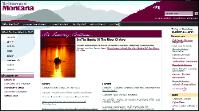 Tired of slogging along in the slower traffic lane of the information superhighway? Ambiguous navigational tools got you down? Help is at hand: After eight months and some 1,400 work hours, the University now offers a new, improved Web site that gives viewers a simple yet comprehensive look at the University, along with access to UM news and events and related University pages.
Tired of slogging along in the slower traffic lane of the information superhighway? Ambiguous navigational tools got you down? Help is at hand: After eight months and some 1,400 work hours, the University now offers a new, improved Web site that gives viewers a simple yet comprehensive look at the University, along with access to UM news and events and related University pages.
Martha Burtis, UM Web development director, and Patia Stephens, Web content manager, along with the University’s Web development committee, created the new site. Stephens produced the news service Today @ UM and will maintain the home page news section.
“Today @ UM was a good start, but I want to make the home page more responsive and make more news available to our readers,” Stephens says.
The home page’s center is dedicated to University feature stories, news headlines, and current events. At the bottom of the page you’ll find “Faces of UM,” casual interviews with various campus personalities and alumni. From the home page, click, point, and navigate anywhere you’d like—from the Mansfield Library to the latest art exhibit to the live, bird’s-eye view of campus on GrizCam. Check it out: www.umt.edu
The University and the Mansion
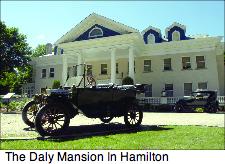 The Bitterroot Valley’s Daly Mansion: historic, cultural, genteel—and UM’s newest outpost. At a signing celebration this summer, the relationship between UM and the mansion became official, as President George Dennison agreed to assume governance of copper baron Marcus Daly’s Hamilton estate from the Montana Historical Society—an alliance approved by the state Board of Regents earlier this year. The new arrangement will enhance and expand educational, cultural, and outreach opportunities, allowing the mansion to work hand-in-hand with the University on projects ranging from Web page design for the mansion to fund-raising events for the University. At the same time, the property will continue to be managed for its historic integrity.
The Bitterroot Valley’s Daly Mansion: historic, cultural, genteel—and UM’s newest outpost. At a signing celebration this summer, the relationship between UM and the mansion became official, as President George Dennison agreed to assume governance of copper baron Marcus Daly’s Hamilton estate from the Montana Historical Society—an alliance approved by the state Board of Regents earlier this year. The new arrangement will enhance and expand educational, cultural, and outreach opportunities, allowing the mansion to work hand-in-hand with the University on projects ranging from Web page design for the mansion to fund-raising events for the University. At the same time, the property will continue to be managed for its historic integrity.
Built in the late 1880s as a summer home for Daly’s family, the mansion was part of the estate known as “Riverside” and included Daly’s 22,000-acre Bitterroot Stock Farm. After Daly’s death in 1900, Margaret Daly, his widow, had the home remodeled into the current structure, a Georgian Revival designed by A.J. Gibson and completed in 1910. The mansion occupies 24,000 square feet on three floors, with twenty-five bedrooms, fifteen bathrooms, and seven fireplaces, five of which are faced with Italian marble. After Mrs. Daly’s death in 1941, the mansion was closed and boarded up until 1987, when it was opened to the public and managed by the historical society.
“It’s a mutual benefit,” says Daly development director Kate Olney. “Students gain knowledge and we gain knowledge. The University has many departments that could really help the Daly Mansion out.”
Under the agreement, the two institutions will team in a mentoring relationship designed to take them a step beyond the more conventional oversight role assigned by Montana law to a nonprofit entity.
With about two thirds of the museum’s $100,000 annual operating budget coming from grants and fund-raising, the mansion’s management could prove to be a big job, a risk that President Dennison thinks is well worth the added exposure for the University.
“Because of the partnership with the Daly Mansion Preservation Trust, the University will not incur additional direct costs,” says Dennison. “Together we can accomplish a tremendous amount by involving the larger community.”
Once Upon A Stage
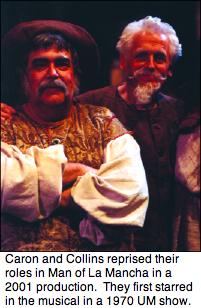 Two well-known Montana figures, UM alumni Jim Caron, M.F.A. ’77, and Don Collins ’95, will be the featured guest artists for UM’s School of Fine Arts 2004 Odyssey of the Stars—A Celebration of Artistic Journeys. The University Theatre stage, where the Caron and Collins collaboration and friendship first began, will be the setting for the fourth annual Odyssey of the Stars.
Two well-known Montana figures, UM alumni Jim Caron, M.F.A. ’77, and Don Collins ’95, will be the featured guest artists for UM’s School of Fine Arts 2004 Odyssey of the Stars—A Celebration of Artistic Journeys. The University Theatre stage, where the Caron and Collins collaboration and friendship first began, will be the setting for the fourth annual Odyssey of the Stars.
This showcase event, a benefit for the School of Fine Arts scholarship fund, features Fine Arts alumni who have gone on to stellar careers in the arts, in concert with current students who dream of just such careers.
Caron is the co-founder and executive director of the Missoula Children’s Theatre and MCT Community Theatre. Caron and Collins founded the company in 1970. For the past thirty years, Collins has appeared on stages throughout the United States and Canada, performing leading roles in New York, Memphis, New Orleans, Portland, and Vancouver, BC.
Scheduled for 7:30 p.m., Saturday, March 20, Odyssey 2004 will include participants from throughout the School of Fine Arts, and will spotlight the department of music. The event will feature more than 200 outstanding UM student performers.
Ste-e-e-e-e-l-l-l-l-la
 Continuing its tradition of presenting plays that explore the depths of the American character and the mysteries of the human heart, the Montana Repertory Theater is staging A Streetcar Named Desire by Tennessee Williams for its 2004 National Tour.
Continuing its tradition of presenting plays that explore the depths of the American character and the mysteries of the human heart, the Montana Repertory Theater is staging A Streetcar Named Desire by Tennessee Williams for its 2004 National Tour.
“No one in America rivals Williams as a poet of the theater,” says Greg Johnson, MRT’s artistic director. “Few other playwrights sought to articulate beauty with such intensity, clarity, passion and empathy for the human experience. Williams’s courage in revealing what we really are to each other is celebrated in every breath of Streetcar. This play is truly worthy of being considered the best American play . . . ever.”
A Streetcar Named Desire opens at the Mount Baker Theater in Bellingham, WA, in January, and will swing through several western states, including Oregon, Colorado, and New Mexico. Returning to Montana, the Rep will perform in Butte, Helena, Bozeman, Billings, Lewistown, Plains, and Missoula, where Streetcar has a weeklong run, culminating in a benefit gala February 19. From there, the MRT production heads east, performing in St. Louis, Savannah, Chattanooga, Green Bay, and other cities in at least eighteen states before winding up the tour in Mt. Pleasant, IA.
For more information, including dates and times, consult MRT’s Web site at www.montanarep.org or phone (406) 243-6809.
Writing in the Blood
 One of Montana’s premier poets, James Welch, Jr., 62, died August 4 in his home in Missoula following a ten-month struggle with lung cancer. The communities that claimed Welch ranged from Montana Indian tribes to the French government, which knighted him in 1995.
One of Montana’s premier poets, James Welch, Jr., 62, died August 4 in his home in Missoula following a ten-month struggle with lung cancer. The communities that claimed Welch ranged from Montana Indian tribes to the French government, which knighted him in 1995.
Welch ’65, Hon. Ph.D., ’97, came to the University in the 1960s where he studied with another literary great, Richard Hugo. Welch was a naïve young man whose first attempts at writing ranged far from his own experiences. Stories of Hugo urging him to write what he knew are legendary. And when Welch wrote what he knew, the literary world stood back and took a breath, beginning with Riding the Earthboy 40, published in 1971, to Winter in the Blood, Fool’s Crow, The Death of Jim Loney, The Indian Lawyer, Killing Custer, and The Heartsong of Charging Elk. His soul shone through his work. He will be mourned for many seasons. – Joan Melcher
Song for the Season
It was September,
September fourth, I think
the night his light went out
in the great bedroom
on the lake. Moontime
seared the junipers
rimming the great house.
September and the mountain ash
was stopped quite cold,
its spindly bole going dead
as though the fingers
of the quite dead man
had pinched a vital nerve.
Think of it. The man had done
so much and now, even
the trees would fold
and wither at his icy touch.
His small boat, tied securely
to the dock, fiddled out
across the lake its dirge.
Too late, he found, that for the great
as well as for the weak,
the wrong instruments ease you out
and the coming on of autumn.
Blackfeet, Blood and Piegan Hunters
If we raced a century over hills
that ended years before, people couldn’t
say our run was simply poverty or promise
for a better end. We ended sometime
back in recollections of glory, myths
that meant the hunters meant a lot
to starving wives and bad painters.
Let glory go the way of all sad things.
Children need a myth that tells them be alive,
forget the hair that made you Blood, the blood
the buffalo left, once for meat, before
other hunters gifted land with lead for hides.
Comfortable we drink and string together stories
of white buffalo, medicine men who promised
and delivered horrible cures for hunger,
lovely tales of war and white men massacres.
Meaning gone, we dance for pennies now,
our feet jangling, dust that hides the bones
of sainted Indians. Look away and we are gone.
Look back. Tracks are there, a little faint,
our song strong enough for headstrong hunters
who look ahead to one more kill.
Poems by James Welch that originally appeared in Riding the Earthboy 40